Shuttle Discovery undocks from space station (UPDATED)
Editor's note...
CBS News
The crew of the shuttle Discovery, given a "Star Trek" send off by actor William Shatner, undocked from the International Space Station early Monday to close out an extended assembly and resupply mission, the shuttle's 13th and final visit to the orbital outpost.
With pilot Eric Boe at the controls, Discovery's docking system disengaged from the station's forward port at 7 a.m. EST (GMT-5) as the two spacecraft sailed through orbital darkness above the western Pacific Ocean northeast of Australia.
"Houston and station, physical separation," commander Steven Lindsey called as the orbiter began backing away.
Manually guiding the shuttle to a point about 400 feet directly in front of the lab complex, Boe kicked off a 360-degree fly-around, looping up over, behind and below the space station to capture photographs and video showing a final U.S. module in place, along with a full complement of visiting spacecraft from Europe, Japan and Russia.
"We've been talking about the long history of the space shuttle, and it's a privilege to get the opportunity to undock and do the fly around of the space station," Boe said during a crew news conference earlier this week.
"What's amazing is how big the structure is. Right now, when we're docked, it's more than a million pounds and to actually fly around the vehicle, take pictures and marvel that the majority of the U.S. segment was brought up, piece by piece, by the space shuttle will be truly amazing."
NASA managers earlier asked their Russian counterparts to consider undocking a Soyuz spacecraft for a fly-about to capture views of the station with Discovery attached. But Russian mission managers, citing technical considerations, declined.
Discovery's fly around took a little more than an hour to complete. At 8:09 a.m., the ship's maneuvering jets were fired in the first of two maneuvers to break away and leave the area.
"Steve, as you guys are heading home, I wanted to say one last time that we really enjoyed your company on board," radioed Expedition 26 commander Scott Kelly, who is scheduled to return to Earth March 16 aboard a Russian Soyuz spacecraft. "And I'm really proud of what we accomplished together as a team here on the space station. But also, including the larger team in Houston and all the control centers around the world.
"Doing something as complicated as this really takes a team effort and that's, I think, what we've proven here this last week. I'd like to wish you guys a safe rest of your fight and a safe landing. And I will see you all back in Houston here in about a week or so."
"Hey Scott, I couldn't agree more, I think the team effort between our two crews and the larger ground team that planned this and put it all together enabled us to get well over 100 percent of our objectives," Lindsey replied. "It's been a pleasure working with your team and I look forward to seeing you guys. Have safe travels for everybody on board and we will see you in about a week."
"OK, take care," Kelly called. "Station out."
Over the course of an extended docked mission, the Discovery astronauts delivered a new storage module, an external spare parts platform, an extra set of radiator panels and several tons of supplies, science gear and other equipment. They also staged two spacewalks to perform a variety of maintenance tasks outside the station and helped out with work to service one of the station's oxygen generators and a carbon dioxide removal system.
Throughout it all, Discovery performed flawlessly, allowing mission planners to extend the docked mission by two days.
"I think if I had to step back and characterize this entire mission, I would really call it an above-and-beyond mission." said Kenneth Todd, chairman of the space station Mission Management Team. "The systems performed very, very well to the point where we were able to add a couple of extra days, which we just don't do that often. ... Being able to get that work behind us now with a larger crew was very, very helpful for us."
But watching Discovery depart early Monday, he said, was a bittersweet moment.
"To see Discovery leave, she had done just a flawless mission for us in support of the program, and yet as she was backing away it was clear to us that that was the last time she was going to visit us," he said. "So we bid her adieu and certainly Godspeed to Steve and the rest of the crew on the way home."
Lindsey, Boe and their crewmates -- Nicole Stott, Michael Barratt and spacewalkers Stephen Bowen and Alvin Drew -- got in the proper spirit for undocking with a 3:23 a.m. wakeup song from Houston that was voted the second most popular in a NASA contest: the Alexander Courage theme from the 1960s television series "Star Trek."
As with the original, Shatner began with the familiar phrase "Space... the final frontier." But the rest was a tribute to Discovery, making its 39th and final flight since its maiden launch in 1984.
"Space... the final frontier," Shatner said as the music played. "These have been the voyages of the space shuttle Discovery. Her 30-year mission: to seek out new science, to build new outposts, to bring nations together on the final frontier, to boldly go and do what no spacecraft has done before."
"And good morning, Houston," Lindsey replied when the music faded. "And that was, I believe, the second most popular selection from the song contest for the space shuttle program and I'd like to thank William Shatner for taking the time to record that special introduction for us."
The song voted most popular in the wakeup music contest -- "Blue Sky" by Big Head Todd and the Monsters -- will be beamed up to the astronauts Tuesday.
The rest of the shuttle crew's day was devoted to carrying out a final inspection of the shuttle's reinforced carbon carbon nose cap and wing leading edge panels to look for any signs of impact damage from micrometeoroids or orbital debris since a similar inspection the day after launch.
The astronauts plan to pack up and test Discovery's re-entry systems Tuesday before dropping out of orbit and landing back at the Kennedy Space Center around noon Wednesday.
That night, starting around 8 p.m., engineers plan to haul the shuttle Endeavour to the launch pad for work to ready the ship for its final blastoff April 19.
Between now and then, the station program faces a particularly busy schedule. Using the lab's robot arm, the Expedition 26 crew plans to move a Japanese cargo ship from the upper port of the forward Harmony module to an Earth-facing port early Thursday.
Kelly and his two Soyuz TMA-01M crewmates -- Alexander Kaleri and Oleg Skripochka -- plan to undock and return to Earth early the morning of March 16, leaving the station in the hands of cosmonaut Dmitry Kondratyev, who will become commander of Expedition 27, Italian astronaut Paolo Nespoli and Catherine "Cady" Coleman.
Three fresh crew members -- Alexander Samokutyaev, Andrei Borisenko and Ronald Garan -- are scheduled for launch March 29, the day after the Japanese HTV cargo ship, loaded with no-longer-needed equipment and trash, is jettisoned for a fiery plunge back into the atmosphere. The Soyuz TMA-21 spacecraft carrying Samokutyaev, Borisenko and Garan is scheduled to dock at the station's upper Poisk module late the night of March 31 U.S. time.
Two-and-a-half weeks after that, the shuttle Endeavour is scheduled for launch on its final visit to the station.
- Posted at 05:09 AM, 03/07/11: Shuttle Discovery set for undocking from space station
- Updated at 07:10 AM, 03/07/11: Discovery undocks from space station
- Updated at 08:40 AM, 03/07/11: Shuttle completes station fly around; heat shield inspection on tap
- Updated at 03:45 PM, 03/07/11: Mission status/MMT briefing; upcoming events
- Updated at 05:30 PM, 03.07/11: Adding fly-around pictures
CBS News
The crew of the shuttle Discovery, given a "Star Trek" send off by actor William Shatner, undocked from the International Space Station early Monday to close out an extended assembly and resupply mission, the shuttle's 13th and final visit to the orbital outpost.
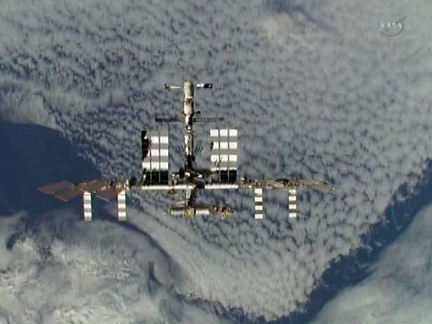 |
| The space shuttle Discovery's view of the International Space Station from directly above as the two spacecraft sailed high above South America. (All photos: NASA TV) |
"Houston and station, physical separation," commander Steven Lindsey called as the orbiter began backing away.
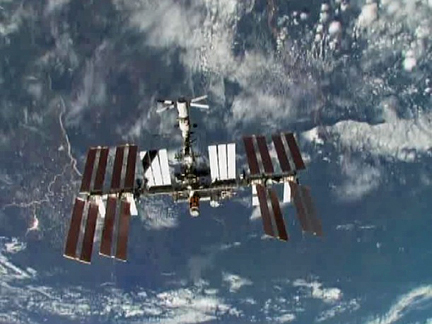 |
"We've been talking about the long history of the space shuttle, and it's a privilege to get the opportunity to undock and do the fly around of the space station," Boe said during a crew news conference earlier this week.
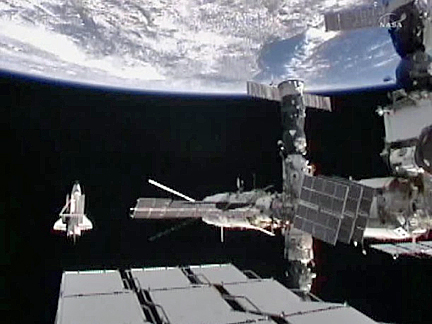 |
| The shuttle Discovery, passing directly behind the space station. |
NASA managers earlier asked their Russian counterparts to consider undocking a Soyuz spacecraft for a fly-about to capture views of the station with Discovery attached. But Russian mission managers, citing technical considerations, declined.
Discovery's fly around took a little more than an hour to complete. At 8:09 a.m., the ship's maneuvering jets were fired in the first of two maneuvers to break away and leave the area.
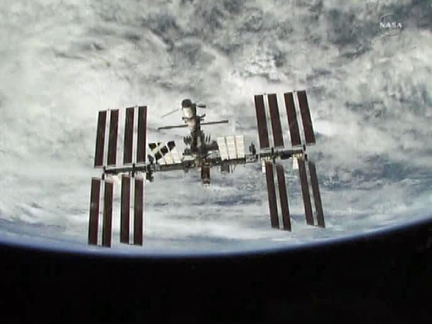 |
"Doing something as complicated as this really takes a team effort and that's, I think, what we've proven here this last week. I'd like to wish you guys a safe rest of your fight and a safe landing. And I will see you all back in Houston here in about a week or so."
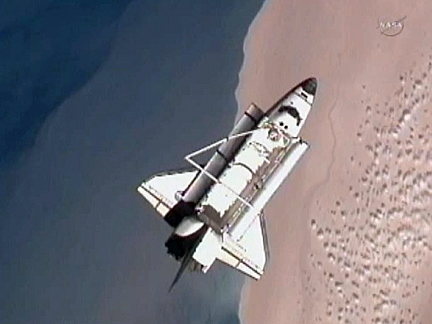 |
| The shuttle Discovery, departing the space station for the final time, appears directly below the outpost. |
"OK, take care," Kelly called. "Station out."
Over the course of an extended docked mission, the Discovery astronauts delivered a new storage module, an external spare parts platform, an extra set of radiator panels and several tons of supplies, science gear and other equipment. They also staged two spacewalks to perform a variety of maintenance tasks outside the station and helped out with work to service one of the station's oxygen generators and a carbon dioxide removal system.
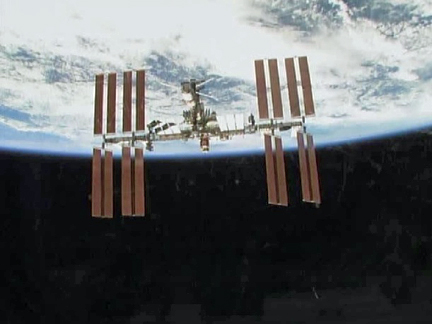 |
"I think if I had to step back and characterize this entire mission, I would really call it an above-and-beyond mission." said Kenneth Todd, chairman of the space station Mission Management Team. "The systems performed very, very well to the point where we were able to add a couple of extra days, which we just don't do that often. ... Being able to get that work behind us now with a larger crew was very, very helpful for us."
But watching Discovery depart early Monday, he said, was a bittersweet moment.
"To see Discovery leave, she had done just a flawless mission for us in support of the program, and yet as she was backing away it was clear to us that that was the last time she was going to visit us," he said. "So we bid her adieu and certainly Godspeed to Steve and the rest of the crew on the way home."
Lindsey, Boe and their crewmates -- Nicole Stott, Michael Barratt and spacewalkers Stephen Bowen and Alvin Drew -- got in the proper spirit for undocking with a 3:23 a.m. wakeup song from Houston that was voted the second most popular in a NASA contest: the Alexander Courage theme from the 1960s television series "Star Trek."
As with the original, Shatner began with the familiar phrase "Space... the final frontier." But the rest was a tribute to Discovery, making its 39th and final flight since its maiden launch in 1984.
"Space... the final frontier," Shatner said as the music played. "These have been the voyages of the space shuttle Discovery. Her 30-year mission: to seek out new science, to build new outposts, to bring nations together on the final frontier, to boldly go and do what no spacecraft has done before."
"And good morning, Houston," Lindsey replied when the music faded. "And that was, I believe, the second most popular selection from the song contest for the space shuttle program and I'd like to thank William Shatner for taking the time to record that special introduction for us."
The song voted most popular in the wakeup music contest -- "Blue Sky" by Big Head Todd and the Monsters -- will be beamed up to the astronauts Tuesday.
The rest of the shuttle crew's day was devoted to carrying out a final inspection of the shuttle's reinforced carbon carbon nose cap and wing leading edge panels to look for any signs of impact damage from micrometeoroids or orbital debris since a similar inspection the day after launch.
The astronauts plan to pack up and test Discovery's re-entry systems Tuesday before dropping out of orbit and landing back at the Kennedy Space Center around noon Wednesday.
That night, starting around 8 p.m., engineers plan to haul the shuttle Endeavour to the launch pad for work to ready the ship for its final blastoff April 19.
Between now and then, the station program faces a particularly busy schedule. Using the lab's robot arm, the Expedition 26 crew plans to move a Japanese cargo ship from the upper port of the forward Harmony module to an Earth-facing port early Thursday.
Kelly and his two Soyuz TMA-01M crewmates -- Alexander Kaleri and Oleg Skripochka -- plan to undock and return to Earth early the morning of March 16, leaving the station in the hands of cosmonaut Dmitry Kondratyev, who will become commander of Expedition 27, Italian astronaut Paolo Nespoli and Catherine "Cady" Coleman.
Three fresh crew members -- Alexander Samokutyaev, Andrei Borisenko and Ronald Garan -- are scheduled for launch March 29, the day after the Japanese HTV cargo ship, loaded with no-longer-needed equipment and trash, is jettisoned for a fiery plunge back into the atmosphere. The Soyuz TMA-21 spacecraft carrying Samokutyaev, Borisenko and Garan is scheduled to dock at the station's upper Poisk module late the night of March 31 U.S. time.
Two-and-a-half weeks after that, the shuttle Endeavour is scheduled for launch on its final visit to the station.